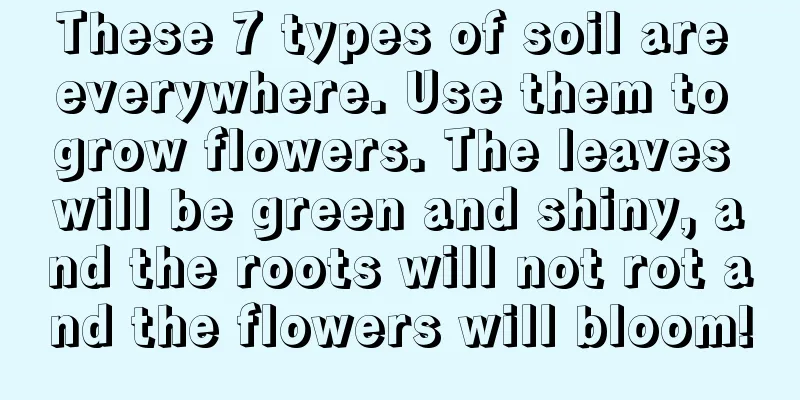How to repot flowers? This way, the branches can be broken when the flowers bloom!

Why change the pot?Generally, if flowers are grown in pots, they need to be repotted once or twice a year because the space in the pots is limited and the amount of culture soil they can hold is also limited. The roots of the plant stretch out and absorb all the nutrients in the culture soil. Once there is no nutrient supply, the growth, development and reproduction of the plant will be greatly hindered. If this happens, you need to change the pot.1. Slow growthI bought the flowers and took good care of them for a long time, but they didn't grow. 2. No floweringI've been growing a pot of flowers for two or three years, but it just won't bloom! 3. Soil compactionI observed the soil in the flower pots and found that it had become hardened. 4. The flower pot has cracksThe walls of the flowerpot are broken. Don't think about it, just change the pot quickly. Specific steps for repottingTake rose as an example 1. Preparation before repottingPrepare a larger flower pot, nutrient soil, base fertilizer, expanded clay, and chlorite in advance. PS: If you use a new flower pot, you should soak it in water beforehand. If you use old flower pots, you should place them in the sun and expose them to the sun for four to five hours to sterilize them. 2. Control water for plants before repottingOne week before repotting, gradually reduce the frequency and amount of watering for the plant, and keep the soil in the pot semi-dry, which will facilitate the subsequent removal of the plant from the pot. 3. Add soil and base fertilizer into the flowerpot.First, spread a layer of expanded clay at the bottom of the flowerpot, two or three centimeters, which will prevent the roots of the plant from rotting. Add a small amount of nutrient soil, some base fertilizer, and then fill in some culture soil, and wait for the plant to be potted. 4. Remove the plant from the pot.If the plant is relatively small, you can simply turn the pot upside down and tap the bottom of the pot to tip the plant out of the pot. If the plant is large, you can first insert an iron bar along the wall of the flowerpot, go around the flowerpot, and separate the soil from the flowerpot. Then turn the pot over and carefully pour out the plant and the soil. As can be seen from the picture, the roots of the rose have extended to the wall of the pot, indicating that most of the nutrients in the potting soil have been absorbed. If the pot is not changed, the growth of the rose will be restricted. Carefully check the growth of the plant's roots. If rotten or aging roots are found, cut them off in time with sterilized scissors and disinfect them with carbendazim. Do not clear away all the old soil, as this will be detrimental to survival. 5. Put it in the pot.Place the plant with soil in the flowerpot, making sure that all the roots of the plant are below the mouth of the flowerpot. Then fill it with nutrient soil and compact it. 6. Watering.Water the plant thoroughly, then wait for the water to soak in before watering again. Generally, after watering three times, the plants in the pots will be watered thoroughly. It is very important to water them after repotting, and make sure they are watered thoroughly. 7. Pave the plants.Covering the surface of the flower pot with chlorite can prevent insects, retain moisture, and protect roots, which is very beneficial to the survival of the plants. 8. Watering.Continue to water the plants after paving, and the repotting work will be successfully completed. What should I pay attention to after repotting?1. Be sure to water after repotting.After repotting the flowers, don't forget to water them, as this is directly related to whether the flowers can survive. Not only should you water immediately, but you should also water thoroughly until water leaks out of the holes in the bottom of the pot. But there is an exception. Don't rush to water succulent plants after repotting them. Wait about one or two weeks before watering them. 2. Do not place the plant in a place with strong light after repotting.After repotting, the plant is in a new soil environment and needs a certain amount of time to adapt and cultivate. At this time, it is best to move the plant to a cool and well-ventilated place to avoid direct sunlight. This will help the plant to grow roots. You can usually spray water on the leaves. 3. Don’t rush to fertilize after repotting.Base fertilizer has been added to the flowerpot when repotting, so there is no need to rush to fertilize the flowers. Generally, fertilizer should be added according to the growth of the plant after three months, and the concentration should not be too high. 4. After repotting, you can prune appropriately according to the situation.After repotting, if the plant has lush branches and leaves, you can appropriately cut off some of the dense branches and leaves. This will help reduce the burden on the plant and reduce water transpiration. |
<<: Does the creeping bellflower need to be pruned?
>>: How to propagate creeping bellflower
Recommend
How to plant Manglietia guinanensis
Planting The growth of Magnolia in southern Guang...
Can grapes be transplanted in winter? Precautions for transplanting grapes in winter
Can grapes be transplanted in winter? If the grap...
Does lipstick bougainvillea bloom frequently?
Bougainvillea is a flower that is deeply loved by...
Apple tree management technology in December
With the arrival of December, heavy snow and the ...
How to make spider plants bloom
1. Variety selection If you want to grow spider p...
How to plant edible lilies and what season is suitable for planting?
Edible lily is a medicinal material and an emergi...
What soil is best for growing cactus?
1. Requirements for soil Although cactus does not...
Why don't marigolds bloom?
Marigold blooms The flowering period of Wanshou i...
Is peony suitable for growing at home (with key points for growing at home)
1. Suitable for keeping at home Peony is a flower...
How to grow gardenia so that it blooms
Gardenia flowering time Gardenia usually blooms i...
What is the best season to plant ginseng? Ginseng planting time and method
There are four main steps in ginseng planting, na...
Can Kalanchoe be grown in pine needle soil?
1. Pine Needle Soil 1. You cannot pile up pine ne...
Planting and management of netted melon
1. Planting time Netted melon can be cultivated i...
What kind of orchids are good to grow indoors in the north and how to grow them
1. What kind of orchids are good to grow indoors ...
Is Impatiens poisonous?
Is it poisonous? The answer is yes! Impatiens is ...









